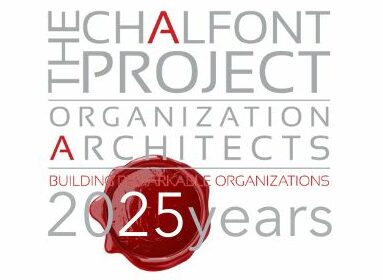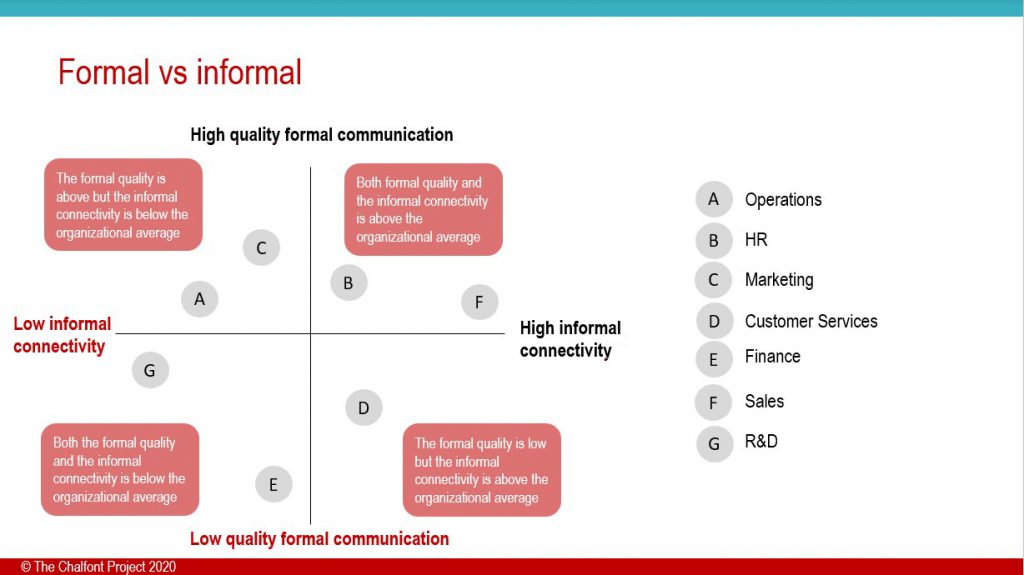Services
Communication, Collaboration, Connectivity
Collaboration is today the Holy Grail of the firm, big or small. Fix collaboration and you are already half way to success. The modern organization functions with a collective brain where all human capital is accessible and useful regardless of geographical or hierarchical boundaries. It is such an important element, a key indispensable behaviour, that we have had a special focus on it since the early days of The Chalfont Project.
Find out more about our consulting interventions:
Aligning Your Teams
Diagnose your Organization’s Health – Connectivity, Communication and Collaboration
Collaborations in the Plural
CREATING SOLID HIGH PERFORMANCE TEAMS: THE FORMAL SIDE OF YOUR INTERNAL COLLABORATION BOOSTED AND RENEWED FAST. OLD TEAMS AND NEW TEAMS WITH A COMMON SENSE OF PURPOSE AND SHARED COMMITMENT TO ACTION
We argue that collaboration is the true competitive advantage for the new era. In light of this, we help you to improve the effectiveness of internal collaborations, by building strong cohesive teams.
FAST ALIGNMENT.
Team building can be achieved in many ways, but crossing rivers, building bridges in the forest or climbing mountains is something that we won’t be able to help you to do. Aligning people in teams is not about convincing them about the merits of doing something by appealing to their common sense. It is about generating a deep understanding of the differences between all of us in the way we prefer to work and the way we make decisions or manage relationships. It’s about creating a common understanding, a common sense of purpose and a shared commitment to action. By cutting out what is irrelevant we focus on what we know will create a fast alignment, whether in M&A mode, during internal restructuring, or simply in the progression of existing teams.
ALIGNING BEHAVIOURS.
In many transformation or restructuring programmes the emphasis is placed on new processes, systems and indeed structures and reporting lines. Very frequently the buck stops there with no provision for the most important and crucial aspect of any new structure: how will people work together. Behaviours are frequently found in the lost property department of so called change programmes.
THE ‘ONE TEAM’ PROCESS
Because sometimes we need to come to the rescue fast, we often use a powerful five-step process that addresses: contextual agreement, alignment of working styles, team chartering, rules of the game and non-negotiable behaviours. This is a way of increasing the effectiveness of the team regardless of its seniority or functionality.
We examine the ways in which people need to interact, handle information, make decisions and organize themselves, in order to determine individual preferences for working together. We create a ‘map of styles’ and examine the strengths/weaknesses of the team in performing the vital tasks needed for producing the team’s ‘product’. Team charter-ing is a very practical exercise that establishes unity of vision and purpose, as well as strong alignment of preferences and teamwork toward established goals. The team also defines, articulates and agrees on new, common, non-negotiable behaviours that they will adopt. Finally, a ‘New Project Anatomy’ (a map of a potential or existing project) is created using an alignment of the previous steps with organization strategy, creating a practical approach for getting the job done. This process can be scaled up simultaneously to many teams.
As you can see, no crossing rivers or arrow- shooting at targets involved. Still fun, but serious hard work.
Informal Networks
THE INFORMAL ORGANIZATION IS RICH IN POSSIBILITIES BUT POOR IN MANAGEMENT TOOLKITS. MOST OF THE GOOD STUFF COMES FROM THE INFORMAL SIDE; MOST OF THE INVESTMENT GOES TO THE FORMAL ONE.
Read on for more details on the tools we use to uncover the informal networks, and the types of outputs you can expect to receive…
Put your company through an MRI
3CXcan - Diagnose your organization's health in terms of it's connectivity, communication and collaboration

If you’re in Internal communications, Group Communications or HR – we’re here to help you better understand the formal and informal social networks in your organization. Our 3CXcan tool provides analysis of the 3C’s – Connectivity, Communication and Collaboration – and is based on the highest scientific principles of network sciences. In the current environment it’s important to base the recovery and the post Covid-19 organization with full understanding of its formal and informal connections, communication channels and internal collaboration.
Suspend judgement about your assumptions of your organization and find the truth. This analytical tool will show real results that will provide a completely new baseline for future-proofing your organization in areas such as internal communications, cross-functional collaboration and team connectivity.
Do you want to know more about
- HOW PEOPLE TRULY COMMUNICATE AND COLLABORATE WITH EACH OTHER?
- HOW FORMAL AND INFORMAL INFORMATION FLOWS IN YOUR ORGANIZATION?
- HOW USEFUL PEOPLE FIND THE INFORMATION THEY RECEIVE?
- HOW PEOPLE WORK TOGETHER ACROSS DEPARTMENTS AND SITES?
- HOW WELL PARTICULAR DEPARTMENTS ARE CONNECTED WITH OTHERS?
- HOW THE INFORMAL CONVERSATIONS TAKE PLACE IN YOUR ORGANIZATION?
3CXcan is an online survey which uses organizational network science software called Cfinder Algorithm, a tool for social network detection, to give you a profound understanding of your internal networks.
It is a diagnostic tool which:
- PROVIDES A PICTURE: of the formal and informal organization and how effectively both operate.
- REVEALS organizational connections from strong to weak/ineffective.
- ADDITIONAL OUTPUT: IDENTIFIES the individuals that will leverage change more effectively (ie your “champions” – following a further opt-in process).
ADDITIONAL FOLLOW-UP WORKSHOP
Following the survey and analysis, you will have the opportunity to work with our consulting team to fully interpret the results, and create a roadmap for the future of your organization by specifically addressing any fault lines in your formal and/or informal connectivity. This roadmap may consider areas such as internal communications, tactics for harnessing peer-to-peer influence, methods for improving collaboration between certain departments etc.
Note:
◦ This process is totally anonymous.
◦ No names are ever revealed (unless there is a specific agreement)
◦ The database of findings is erased soon after the debriefing has taken place.
Example 3CXCAN Outputs
Contact us now for a free consultation or a short walk through our demo.
Collaborations In The Plural
HOW TO HOST DIFFERENT STYLES OF COLLABORATION UNDER ONE ROOF? YOU MAY NEED TO LEAVE YOUR COMFORT ZONE. THE ONE THAT THE UNIFORMITY OF ‘ONE WAY OF MANAGING’ GIVES. DIVERSITY WILL PAY OFF.
TRAPPED IN UNIFORMITY
The modern organization is obsessed with uniformity: one organization chart, one way of doing things, one reporting system, one set of teams. This is all done (mistakenly) on behalf of ‘one culture’. As a consequence you may end up running organizations in which all divisions and groups are treated in the same way. Everything feels the same, looks the same and smells the same. Yet all your organizational pieces may in reality be very diverse in aims, closeness to the customer, product life cycles, pace and styles of working or kinds of people. You may be sacrificing the richness of diversity on behalf of a more comfortable homogeneity: similar processes, similar reporting, similar structures, similar assessment. Management may have an illusion of control whilst everybody else suffers the discomfort of the straightjacket.
CO-EXISTING TIGHT AND LOOSE SPACES
Your organization is a landscape of multiple collaborative spaces, each of which need to be crafted on their own merits. Some of them may need to work on a pretty loose arrangement, yet with a very tight sense of direction. Other parts may need to be run in a far tighter way. One reason why people do not tend to allow such diversity is for fear of increasing complexity in management. So we have organizations which often end up running to the tune of the lowest common denominator, stifling creativity in the areas where this should be high or being too loose in areas which need a very precise set of systems and processes. Parts of your organization where processes are naturally heavy will tend to crave for a more relationship style of environment, and those who are heavy in relationships are craving for ‘more structure and discipline’. Everybody feels a bit homesick.
FIT FOR PURPOSE, DIFFERENT MODELS, ONE ROOF.
We will bring to you a way to diagnose and map the different collaborative spaces in your organization. We will assess their balance and fit for purpose in the way they are run and will establish ways of correction (migration) when needed. We will help you to put in place the management and leadership capabilities to be able to host all different spaces without falling into the trap of rigid uniformity. We will guide and coach you to make the most of the diversity under one roof even if it takes you beyond your zone of comfort of uniformity and homogeneity. We will help you to deal with that. The result is an organization run with all the advantages of flexibility and all the safeguards of good governance.
The details you provide will be added to our mailing list and be used to keep you updated on news, products and/or services of relevance. To update your preferences or opt out, please email [email protected]


